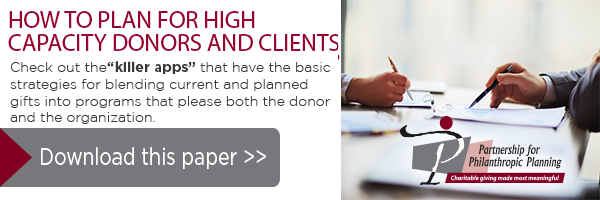
The National Conference on Philanthropic Planning is a meeting place for all the advisors who sit around the planning table. Steve Meyers, Phil Cubeta and Tim Belber got together to present an approach to blended giving that makes sense to donors and their estate and financial planners and creates immediate impact for the organization receiving the gift.
The entire point of endowment and other approaches for building legacies is to create a stream of annual revenues to sustain a program. It’s sometimes possible to obtain the corpus initially, but it may be much easier to provide that stream of annual gifts needed to maintain the program. In fact, you may already be receiving the funds, though in a less decisive or intentional way.
With a simple approach—focusing on the stream of annual gifts first—many programs can be established that would otherwise never see the light of day. For example, a traditional endowment of $100,000 produces $5,000 of spending, with a 5% spending rate. Many more donors can give $5,000 per year than $100,000 as a lump sum. Thus, even modest annual gifts (in the context of lifetime and estate giving) can have all the impact and power of major gifts IF they aren’t segregated in the organizational silos of annual, major and planned.
These are the “killer apps”—basic strategies for blending current and planned gifts into programs that please both the donor and the organization.
- Virtual Endowment: the donor combines and in effect chains together a series of current gifts of a spending rate amount that will maintain a program with a future gift (a bequest or other balloon payment) to endow the program.
- Philanthropic Mortgage: the donor’s annual gift commitment covers an amount greater than that needed for maintenance of the program. The surplus amount is used to gradually build equity in an endowment or a legacy fund until the fund is fully established and able to sustain the program for the future. The donor doesn’t have to wait until her gift is fully paid to enjoy being a benefactor.
- Step-up Gifts: The donor establishes a gift at a starting level with an outright gift or, alternatively, current spending rate annual gifts, and then steps it up. Impact can begin now, with assurance you will achieve your greatest goals over time, e.g., growing your support from a master’s scholarship to a doctoral scholarship to a professorial chair.
Read the full paper via the download option below and learn more about how the apps are applied.
Authors: Philip B. Cubeta, Steven L. Meyers, and Timothy J. Belber

